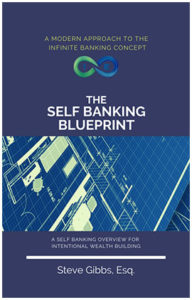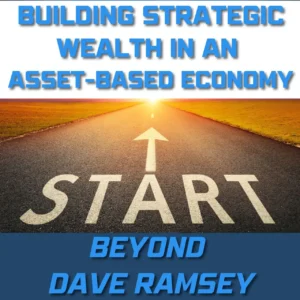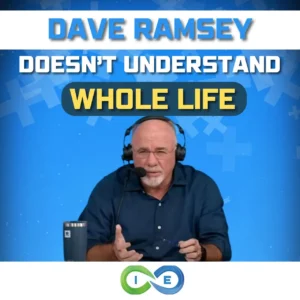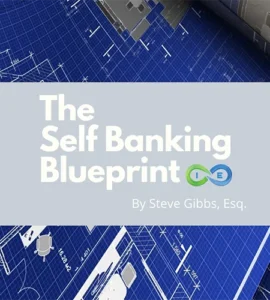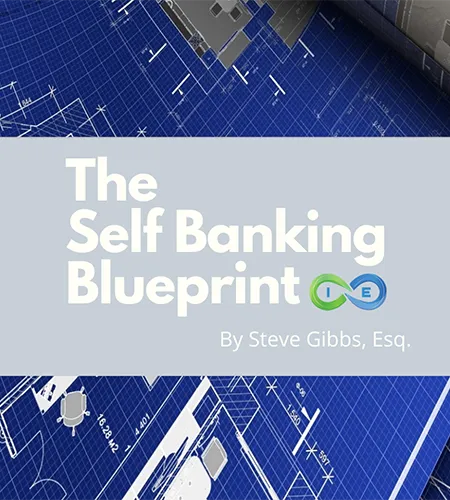About the Author
Steve Gibbs, JD, AEP® is CEO and Co-Founder of Insurance and Estate Strategies LLC. With 15+ years of estate planning experience as a licensed attorney in multiple states, Steve specializes in strategic life insurance design and wealth transfer strategies. He holds the prestigious AEP® certification for multi-disciplinary estate planning expertise and is a Penn Mutual Century Club award recipient. Read full bio →
Table of Contents
- Why Most People Get Debt Wrong
- Understanding Good Debt vs Bad Debt
- Traditional Wealth-Building Debt Strategies
- The $165 Billion Secret Banks Don’t Want You to Know
- Advanced Strategic Debt: How the Wealthy Really Use Leverage
- Volume-Based Banking: Beyond Traditional Good Debt
- How to Implement Strategic Debt Safely
- Common Mistakes That Destroy Wealth
- Your Next Steps
Why Most People Get Debt Wrong
When Apple needed $25,000 to fulfill their first major order in the 1970s, they faced a choice: use their limited cash reserves or borrow the money. They chose debt. That strategic borrowing decision helped create what became a trillion-dollar company.
Meanwhile, conventional financial advice tells families to avoid debt entirely, pay cash for everything, and keep emergency funds in low-yield savings accounts. This creates a puzzling contradiction that reveals why most people struggle to build real wealth while institutions and the ultra-wealthy use debt strategically to multiply their money.
According to industry data, Americans hold over $1.2 trillion in credit card debt, yet banks simultaneously hold $165 billion in specialized debt instruments for their own wealth building. The difference isn’t the debt itself but in understanding how to use leverage as a tool rather than a trap.
Key Takeaway
Consumer debt destroys wealth through high interest rates and depreciating purchases. Strategic debt creates wealth by acquiring appreciating assets while maintaining liquidity. The wealthy understand this distinction and leverage it systematically.
Understanding Good Debt vs Bad Debt
Most financial education oversimplifies debt into two categories, good debt vs bad debt, missing the critical third level that separates the wealthy from the middle class.
Bad Debt: The Wealth Destroyer
Bad debt finances consumption at high interest rates with no potential for returns:
- Credit cards at 24-29% for lifestyle expenses
- Auto loans for rapidly depreciating vehicles
- Personal loans for vacations and purchases
- Payday loans at 400%+ annual rates
Research confirms that the average American with credit card debt owes over $6,400 per person, creating a wealth trap where interest payments consume increasing portions of income.
Traditional Good Debt: Still Playing by Their Rules
Financial advisors guide people toward this category, teaching them to be better customers of the banking system:
- Mortgages: Real estate loans that build equity over time as home values appreciate
- Student loans: Education financing that increases earning potential throughout your career
- Business loans: Capital for ventures that generate returns exceeding borrowing costs
- Investment property loans: Leverage for cash-flowing rental assets
While these debt types can build wealth, they maintain your dependence on external institutions. Banks decide when you qualify, how much you can borrow, and under what terms.
Strategic Debt: The Institutional Level
Here’s what separates the wealthy from everyone else: they don’t just use good debt—they control their own banking systems. Instead of hoping banks approve their applications, they create their own liquidity while maintaining asset growth simultaneously.
Key Takeaway
Consumer debt makes you a victim. Traditional good debt makes you a customer. Strategic debt makes you the controller of your own financial system. This progression determines your wealth-building potential.
Traditional Wealth-Building Debt Strategies
Before exploring advanced strategies, let’s examine how traditional good debt builds wealth and where it falls short.
Mortgage Leverage: Building Equity Over Time
Studies demonstrate that American home values have risen 230% over the last 30 years. A mortgage allows you to control a $400,000 asset with a $80,000 down payment, amplifying returns through leverage.
The mathematics work when home appreciation exceeds borrowing costs. If your property appreciates 4% annually while your mortgage costs 3%, you profit from the 1% spread on the entire property value, not just your down payment.
Student Loan Investment: Human Capital Development
College graduates earn approximately $1.2 million more over their lifetimes compared to high school graduates. Analysis reveals that even with average student debt of $37,000, the return on investment exceeds most traditional investments when measured over a career.
Critical Warning: Student loans carry unique risks that separate them from other “good debt.” Unlike mortgages, they cannot be discharged in bankruptcy and offer no underlying asset. Current federal rates reach 9.08% for graduate/parent PLUS loans, and the government can garnish wages and benefits without court orders. Many borrowers find balances growing despite making payments due to negative amortization.
Business Debt: Scaling Operations
Business loans enable entrepreneurs to scale operations faster than organic growth allows. Instead of saving for equipment purchases, you can deploy capital immediately and use business profits to service debt while building enterprise value.
Investment Property Leverage: Cash Flow Plus Appreciation
Real estate investors use debt to control multiple properties with limited capital. A $100,000 down payment can control five $200,000 rental properties instead of one paid-in-full property, multiplying both cash flow and appreciation potential.
The Traditional Limitation
These strategies all share a common weakness: they require external approval and qualification. Your borrowing capacity depends on credit scores, income verification, and lender policies—not your own financial strategy.
Key Takeaway
Traditional good debt strategies can build wealth but keep you dependent on external institutions for approval. The next level involves creating your own approval system.
The $165 Billion Secret Banks Don’t Want You to Know
While banks tell customers to avoid debt and keep money in low-yield savings accounts, they hold over $165 billion in Bank-Owned Life Insurance (BOLI) for their corporate reserves. This isn’t insurance to protect against executive deaths—these are specially designed financial instruments that provide:
- Tax-deferred growth on cash reserves
- Liquidity through policy loans without tax consequences
- Stable returns independent of market volatility
- Regulatory capital advantages under banking requirements
Industry data shows that insurance companies manage over $7.6 trillion in assets using similar strategies, collecting premiums and deploying capital into investments while using returns to pay claims and build reserves.
The Institutional Contradiction
This creates an uncomfortable question: If life insurance-based banking strategies are ineffective, why do the most sophisticated financial institutions use them extensively for their own reserves while discouraging individual customers from accessing similar tools?
The answer reveals the difference between institutional knowledge and consumer marketing. Financial institutions understand that properly structured life insurance provides guaranteed growth with unmatched liquidity and tax advantages.
How Elon Musk Uses $20 Billion in Strategic Debt
Elon Musk could afford to buy Twitter with cash by selling Tesla stock. Instead, he borrowed billions against his Tesla holdings. Why would someone with that wealth choose debt over cash?
The strategy demonstrates four wealth-preservation principles:
- Tax Avoidance: Selling stock triggers capital gains taxes; borrowing against shares avoids immediate tax consequences
- Asset Preservation: Tesla stock continues appreciating while borrowed funds provide liquidity
- Control Maintenance: Borrowing preserves ownership percentages and voting control
- Interest Rate Arbitrage: When asset appreciation exceeds borrowing costs, the spread creates additional wealth
This demonstrates mathematical optimization, using debt as a strategic tool rather than a burden.
Key Takeaway
Institutions use strategies for their own reserves that they discourage customers from accessing. Following institutional behavior rather than institutional advice reveals advanced wealth-building approaches.
Advanced Strategic Debt: How the Wealthy Really Use Leverage
Strategic debt differs fundamentally from traditional borrowing because it eliminates the approval process. Instead of seeking external validation, you create your own banking system where money works in multiple places simultaneously.
The Double-Duty Dollar Principle
Traditional banking forces a choice: keep money growing or access it for opportunities. Strategic debt eliminates this false choice by allowing capital to compound while being deployed elsewhere.
When wealthy individuals borrow against appreciating assets, their money literally works in two places at once—earning returns in the original investment while funding new opportunities through loans secured by those same assets.
Crisis Deployment Advantage
Market crashes create the best investment opportunities, but most people lack capital access during these periods. Market analysis reveals that during the 2008 financial crisis, real estate prices dropped 30-50% while traditional lending disappeared.
Investors with strategic debt capabilities could deploy immediately:
- Access capital without bank approval during credit freezes
- Purchase distressed assets at significant discounts
- Benefit from subsequent recovery and appreciation
- Deploy while others were forced to sell in panic
The same pattern repeated during March 2020 when COVID created opportunities across multiple asset classes while traditional financing evaporated.
Speed of Opportunity
Strategic debt provides capital access at the speed of opportunity rather than the speed of bureaucracy. When competitors or suppliers face financial difficulties, strategic debt users can respond immediately rather than waiting weeks for loan approval.
Key Takeaway
Strategic debt provides countercyclical deployment capability, allowing capital access during market crises when traditional financing disappears. This timing advantage often generates the highest returns over long-term periods.
Volume-Based Banking: Beyond Traditional Good Debt
Volume-Based Banking (VBB) represents the evolution beyond traditional debt strategies, focusing on three core principles that multiply money’s effectiveness:
Volume: Money Working Multiple Places
Instead of choosing between saving and investing, VBB allows the same dollars to compound in secure accounts while simultaneously being deployed in opportunities. This eliminates the opportunity cost that destroys traditional savings strategies.
Expert analysis reveals that properly designed systems can provide immediate access to 90-95% of accumulated value while the full amount continues earning guaranteed returns plus potential dividends.
Velocity: Speed of Capital Deployment
Traditional wealth building requires saving, then investing, then starting over. VBB maintains continuous deployment where capital works immediately while reserves continue growing. This velocity multiplication compounds over time as each successful deployment increases future capacity.
Value: Multiple Income Stream Creation
VBB enables systematic leverage where each successful investment creates collateral for additional opportunities. Instead of linear wealth building, this creates exponential growth through compound leverage effects.
The Implementation Vehicle
While various instruments can facilitate VBB principles, properly designed whole life insurance policies offer unique advantages:
- Guaranteed Growth: 4-6% annual returns regardless of market conditions
- Tax-Free Access: Policy loans avoid taxable events while preserving growth
- No Qualification Required: Your own asset provides collateral without external approval
- Flexible Repayment: Self-directed loan terms based on your strategy, not bank requirements
- Permanent Death Benefit: Wealth transfer advantages that compound benefits
The key is proper design—these policies must be structured for cash value optimization rather than traditional death benefit maximization.
Key Takeaway
VBB transforms traditional either/or financial decisions into both/and opportunities. Your money compounds while being deployed, creating velocity that traditional strategies cannot match.
How to Implement Strategic Debt Safely
Moving from traditional debt strategies to strategic debt requires careful progression through three distinct phases.
Phase 1: Foundation Building (6-24 months)
Before implementing strategic debt, eliminate wealth-destroying obligations:
- Priority Order: Credit cards, auto loans, personal loans, any consumption debt
- Foundation Elements: Stable income, expense control, basic emergency reserves
- Mindset Development: Transition from scarcity to abundance thinking about money
Research indicates that this foundation phase typically requires 6-24 months depending on existing debt levels and income stability.
Phase 2: System Design (3-6 months)
Strategic debt requires properly structured vehicles designed for cash value optimization:
- Policy Design: Maximum premium contributions through paid-up additions riders
- Premium Guidelines: 10-20% of gross income for optimal results, minimum $10,000-15,000 annually
- Company Selection: Mutual companies with 100+ year dividend payment histories
- Professional Guidance: Specialists in advanced policy design, not traditional insurance agents
Phase 3: Strategic Deployment (Years 3-7+)
Once cash values reach substantial levels (typically $50,000+), deployment becomes possible:
- Initial Opportunities: Real estate down payments, business equipment, market downturns
- Scaling Strategies: Use returns to fund additional premiums and larger opportunities
- Portfolio Development: Multiple policies for different family members and purposes
- Legacy Planning: Multi-generational wealth transfer strategies
Risk Management Protocols
Strategic debt implementation requires systematic risk management:
- It is prudent to limit borrowing to no more than 80% of available cash value
- Ensure deployment generates returns exceeding borrowing costs
- Maintain adequate liquidity for loan service from other income sources
- Diversify across multiple asset classes and opportunities
- Regular performance review and strategy adjustment
Key Takeaway
Strategic debt requires foundation work first. Eliminate consumer debt, build discipline, then design proper systems before deployment. Proper sequencing creates sustainable wealth building rather than speculative gambling.
Common Mistakes That Destroy Wealth
Understanding implementation pitfalls prevents costly errors that undermine strategic debt success.
Mistake 1: Wrong Vehicle Design
The Problem: Traditional insurance agents design policies for death benefit maximization rather than cash value optimization, creating high fees and poor performance.
The Solution: Work exclusively with agents trained in advanced policy design who understand the mathematics of cash value acceleration versus death benefit focus.
Mistake 2: Premature Deployment
The Problem: Attempting loans before adequate cash value accumulation or over-borrowing beyond sustainable repayment capacity.
The Solution: Wait until substantial cash values develop and deploy only into thoroughly researched opportunities with clear repayment plans.
Mistake 3: Tax Compliance Failures
The Problem: Funding too quickly triggers Modified Endowment Contract (MEC) status, eliminating tax advantages, or improper documentation for business interest deductions.
The Solution: Professional guidance from specialists who understand insurance taxation and estate planning implications.
Mistake 4: Emotional Decision Making
The Problem: Using strategic debt for consumption or speculative investments rather than systematic wealth building.
The Solution: Strict deployment criteria focusing on cash-flowing assets with proven track records rather than get-rich-quick schemes.
Warning Signs Requiring Immediate Attention
- Policy loan balances growing faster than cash values
- Deployment returns consistently below borrowing costs
- Inability to service loans from investment income
- Excessive concentration in single asset classes
- Using strategic debt for lifestyle expenses
Key Takeaway
Strategic debt success requires professional implementation and systematic discipline. Most failures result from wrong design, premature deployment, or emotional decision-making rather than strategy flaws.
Your Next Steps
The evidence reveals a clear pattern: successful individuals and institutions use debt strategically while conventional wisdom encourages avoidance. This reflects fundamental differences in understanding how modern financial systems operate.
The Knowledge Gap
Most people will continue following traditional advice because it appears safer and requires less learning. However, those who implement strategic debt often achieve dramatically different outcomes over time. The mathematical differences compound annually, creating enormous wealth gaps over decades.
Implementation Reality
Understanding these concepts changes nothing unless it changes actions. The question isn’t whether strategic debt works—institutional evidence proves its effectiveness. The question is whether you’ll implement strategies designed for wealth creation or continue following advice designed for wealth preservation.
Your Choice
You can continue using traditional good debt strategies that maintain dependence on external approval while your money sits idle between opportunities. Or you can explore the advanced strategies that institutions use for their own wealth building.
The choice isn’t between safety and risk—properly structured strategic debt provides more safety through guaranteed growth AND permanent liquidity. The choice is between conventional dependency and strategic control of your financial future.
Educational Resources
Before making any decisions, continue your education with these related articles that explore specific aspects of strategic wealth building:
- “Why Dave Ramsey’s Advice Keeps You Poor: The Missing Piece“
- “The Ultimate Asset: How Wealthy Families Really Build Generational Wealth“
- “Volume-Based Banking vs. Traditional Banking: A Mathematical Comparison
Remember: Strategic debt represents advanced wealth-building concepts that require proper education, professional guidance, and systematic implementation. Most people encountering these ideas for the first time need months or years of additional learning before implementation becomes appropriate.
Final Takeaway
Knowledge without action maintains the status quo. Strategic debt offers proven wealth-building advantages, but only implementation creates results. The choice between conventional dependence and strategic control determines your financial trajectory.
Frequently Asked Questions
Q: Is strategic debt just fancy terminology for risky borrowing?
A: No. Strategic debt uses your own assets as collateral with guaranteed growth rates, eliminating external approval requirements. It’s mathematically conservative compared to traditional lending.
Q: How is this different from a home equity line of credit?
A: Home equity requires bank approval and qualification. Strategic debt uses your own banking system with no external approval needed. Your asset continues growing while borrowed money is deployed.
Q: What if the insurance company fails?
A: State guarantee funds protect policyholders, and mutual companies have operated successfully for over 150 years. The track record exceeds most financial institutions.
Q: Don’t I need a lot of money to start?
A: Strategic debt scales with income. Minimum effective premiums start around $10,000-15,000 annually, but the principles work at higher levels for greater impact.
Q: How long before I can start using strategic debt?
A: Typically 3-5 years to build substantial cash values for meaningful deployment. The foundation phase (eliminating bad debt) comes first.
